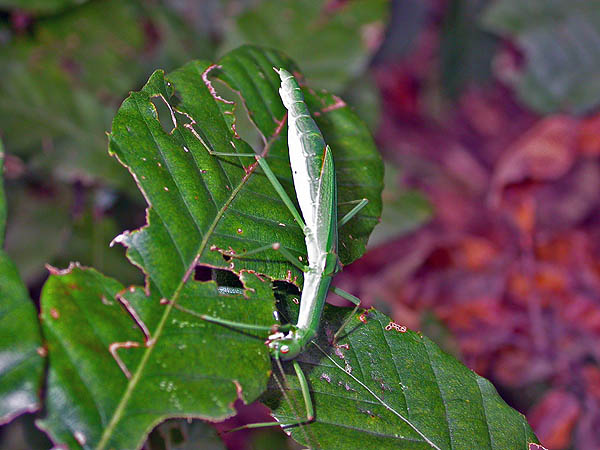분홍날개대벌레
[=나는대벌레]
Micadina phluctainoides (Rehn
1904)
몸길이는 약 40-50 ㎜이며 녹색이다. 뒷날개는 선명한 분홍색이다. 더듬이는 홍갈색으로 길고 가늘며 눈 뒤에 황색 줄무늬가 있다. 앞날개는 매우 짧으며 폭과 길이가 비슷하다. 가운데가슴 옆가두리에 적갈색띠와 앞날개 앞가두리에 밝은 색조가 있다. 알의 표면에는 그물 무늬가 발달한다. 일본에도 분포한다.

암컷
(Female)
Allied to M. sumatrensis Brancsik from Sumatra, but differing in the shorter mesonotum, the compressed ninth abdominal segment, the non-annulate antennae and the different color pattern of the tegmina. Brancsik's Necroscia papuana from the New Guinea and Westwood's ismene from Borneo are apparently related to phluctainoides, but very distinct species.
♂. -Size rather small; form slender; surface of head subglabrous, of thoracic segments granulose. Head rather large, moderately depressed, somewhat inflated, the posterior portion subequal in width, occiput with a faint median sulcus; eyes ovate, prominent; basal joint of the antennae slightly depressed, longer than broad, second joint longer than broad and not equal to the basal joint in size, total length of the antennae about equal to that of the abdomen. Pronotum quadrate, with a fine median longitudinal sulcus and a well-marked transverse sulcus which is placed before the middle. Mesonotum somewhat over three times the length of the pronotum, subequal anteriorly, slightly expanded posteriorly, very distinct median and lateral carinae present, all becoming rather evanescent posteriorly, surface rugoso-tuberculate. Tegmina short, subtruncate apically, raised portion of moderate elevation, rounded. Wings large, damaged in the type, but apparently reaching the apex of the abdomen in the perfect specimen. Abdomen slender, the six basal segments longitudinal and slightly decreasing in length apically; eighth segment slightly longer than the seventh, both carinate, the seventh slightly expanded apically, the eighth slightly compressed; ninth segment about equal to the seventh in length, compressed, subtectate, apex truncate when viewed from the dorsum; cerci about reaching to the apex of the ninth segment, subequal, slightly incurved; supra-anal plate absent; subgenital opercule reaching to the apex the eight dorsal segment, rotundato-truncate. Anterior femora somewhat exceeding the pronotum and mesonotum in length, considerably curved basally; tibiae slightly shorter than the femora; metatarsi very slender, equal to the remaining tarsal joints in length. Median and posterior limbs absent.
General color purplish-brown, rather pale on the proximal portion of the anterior femora. Tegmina with the elevation black, bordered laterally by a longitudinal bar of pinkish-purple.
♀. -Size medium; form rather robust; surface of mesonotum and tegmina rugose. Head inflated, slightly elongate; eyes ovate, moderately prominent; antennae slightly exceeding half the length of the body, basal joint longitudinal and considerably depressed, second joint cylindrical, considerably smaller than the basal joint. Pronotum quadrate, very slightly constricted posteriorly, anterior margin with a shallow emargination, median sulcus not marked posteriorly, the transverse ante-median sulcus very distinct. Mesonotum equal in length to the posterior tibiae, rather broad, gradually expanding posteriorly; median and lateral carinae very distinct; surface rugose-tuberculate. Tegmina short, subquadrate; apex subtruncate; elevated point slight, low and rounded. Wings short, reaching to the apex of the third abdominal segment, width about three-fourths of the length; costal area coarsely reticulate; radial vein furcate. Abdomen somewhat inflated, the six basal segments all transverse and subequal in length, the second and third of the greatest and the six of the least width; seventh and eighth segments tectate, subequal in length; ninth segment slightly longer than the eighth, the apex somewhat produced, truncate and with a slight triangular median emargination; supra-anal plate with the apex alone visible; cerci straight, reaching to the apex of the ninth segment; subgenital opercule tectate, acuminate, the tip acute and reaching to the apex of the eighth segment. Egg almost ready to deposit in position in oviduct, general shape apparently oval, surface rugose. Limbs short, terminal tarsal joint of each foot provided with a large arolium. Anterior femora slightly exceeding the mesonotum in length, basal section strongly bowed; tibiae slightly shorter than the femora; metatarsi slightly shorter than the remaining tarsal joints. Median femora and tibiae short, the former slightly longer than the latter, neither exceeding the length of the two basal segments of the abdomen; metatarsi considerably shorter than the pronotum and mesonotum together; tibiae slightly shorter than the femora; metatarsi much shorter than the remaining tarsal joints, the second joint alone being half the length of the metatarsus.
General color grass-green, most intense on the mesonotum, tegmina and costal region of the wings. Antennae dull purplish, pale basally; eyes wood-brown, with a narrow longitudinal bar of darker brown; postocular region with a faint line of yellowish. Mesonotum with the lateral carinae chrome-yellow. Tegmina with the chrome-yellow line of the mesonotum continued to the apical margin, flanked internally by a line of blackish. Wings with the posterior portion roseate-pink.
Measurements.
|
♂ |
♀ |
Total length |
40 ㎜ |
50 ㎜ |
Length of pronotum |
1.7 |
2.5 |
Length of mesonotum |
7 |
10 |
Length of tegmina |
2.5 |
3 |
Length of wings |
19+ |
16.5 |
Length of abdomen |
22.5 |
26.5 |
Length of anterior femora |
11 |
11.5 |
Length of anterior tibiae |
9.5 |
9.5 |
Length of median femora |
|
7.5 |
Length of posterior femora |
|
11.7 |
This species is based on a series of sixteen individuals, fifteen of which are females. No appreciable difference exists in all the series, except in the intensity of the green coloration of the body, which is clearly due to the fading of the natural tint.
|
유충 |
1월 |
2월 |
3월 |
4월 |
5월 |
6월 |
7월 |
8월 |
9월 |
10월 |
11월 |
12월 |
|
성충 |
1월 |
2월 |
3월 |
4월 |
5월 |
6월 |
7월 |
8월 |
9월 |
10월 |
11월 |
12월 |
<참고문헌>
●
Kwon YJ, Ha JS and Lee CE. 1992. Classification of the order Phasmida from Korea. Nature and Life 22(2): 43-58.
●
Rehn JAG. 1904. Studies in the Orthopterous Family Phasmidae. Proc. Acad. Nat. Sci. Philadelphia, 38-107.